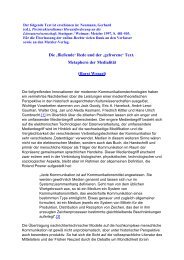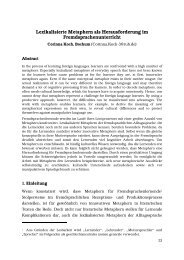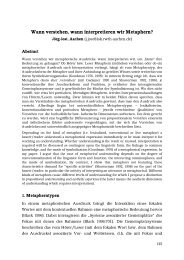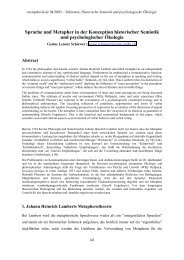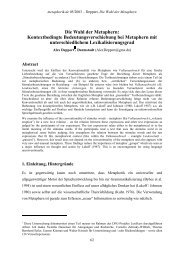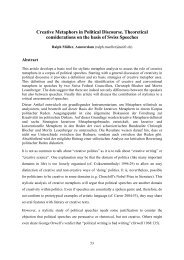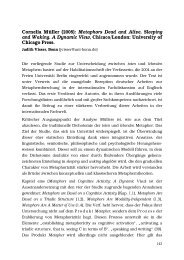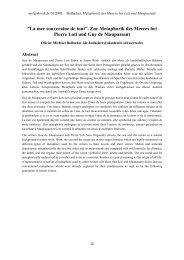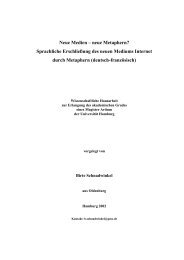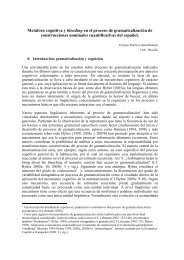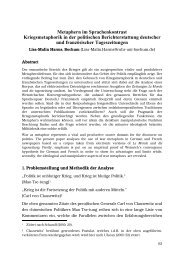The Sweet Smell of Red - An Interplay of ... - metaphorik.de
The Sweet Smell of Red - An Interplay of ... - metaphorik.de
The Sweet Smell of Red - An Interplay of ... - metaphorik.de
Create successful ePaper yourself
Turn your PDF publications into a flip-book with our unique Google optimized e-Paper software.
62<br />
<strong>metaphorik</strong>.<strong>de</strong> 18/2010<br />
As Eysenck (1993:11) says, „perception refers to the way in which we interpret<br />
the information gathered (and processed) by the senses”, interpretation being<br />
the crucial part in this process.<br />
Synaesthetic metaphors exist in two forms, weak and strong. Interestingly<br />
enough, this distinction completely agrees with the neurological distinction <strong>of</strong><br />
higher and lower (Ramachandran & Hubbard 2001), respectively strong and<br />
weak synaesthesia (Martino and Marks 2002). <strong>The</strong> most common form <strong>of</strong><br />
synaesthesia (grapheme-color synaesthesia) is, strictly speaking, not a<br />
combination <strong>of</strong> two senses, but rather a cross-modal combination as color<br />
(vision) is interlinked with letters, words or numbers. <strong>The</strong>refore this type <strong>of</strong><br />
synaesthesia is called weak... Only the strong type, which is much rarer,<br />
combines two actual sense experiences like seeing sounds for example.<br />
Synaesthetic metaphors exist in those two forms as well. <strong>The</strong> difference<br />
between weak and strong forms is the target domain, this means, the structure<br />
<strong>of</strong> strongly synaesthetic metaphors combines a synaesthetic modifier with a<br />
synaesthetic head, while in weak metaphors only the source domain comes<br />
from a perceptual domain. <strong>The</strong> source domain has to be perceptual, otherwise<br />
a metaphor cannot be called synaesthetic. Differently put, in strongly<br />
synaesthetic metaphors the target as well as the source domain are both<br />
perceptual, while weakly synaesthetic metaphors only show one perceptual<br />
domain.<br />
3. <strong>The</strong> senses<br />
How many human senses are there? <strong>The</strong> answer is not that simple. <strong>The</strong> most<br />
common assumption is that there are five senses. <strong>The</strong>se are vision, hearing,<br />
taste, smell and touch. We might consi<strong>de</strong>r this division as logical and natural,<br />
as we view the senses mostly as limited to receiving data from the world in a<br />
passive rather than an active way. This question, however, has been discussed<br />
by many people and is not a very recent one either. Day (1995:23) explains that<br />
this division <strong>of</strong> the senses into five is plainly culturally based and there are<br />
other cultures which acknowledge more senses, others less. Again, it was<br />
Aristotle who was involved in the question <strong>of</strong> the division <strong>of</strong> the senses and<br />
set the standard <strong>of</strong> five that we view as normal nowadays. A further division<br />
<strong>of</strong> touch into the additional temperature and pain perception is possible.<br />
Furthermore, Aristotle <strong>de</strong>clared the ranking <strong>of</strong> the senses to be in the or<strong>de</strong>r <strong>of</strong>



